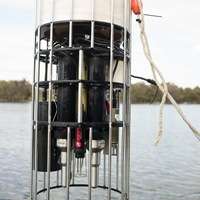Phytoplankton use turbulence to survive

A unique water profiling instrument developed by The University of Western Australia's Centre for Water Research (CWR) is enabling scientists to understand the impact of even the most subtle turbulence on algal populations.
The new state-of-the-art Portable Flux Profiler (PFP) is equipped with high resolution sensors that can yield millimetre-scale measurements.
The instrument has enabled researchers to demonstrate the influence of turbulent micro-scale motions - such as those caused by wind and currents - on phytoplankton communities in coastal waters. Such information can help predict the potential for problems like algal blooms.
According to a study led by recently graduated PhD student Daniel Machado and published in the journal Estuarine, Coastal and Shelf Science, some forms of phytoplankton do better than others when faced with turbulence.
The researchers were able to show that diatoms, one of the most common groups of phytoplankton, were better able to secure and make use of mobile nutrients in such conditions than dinoflagellates. This meant they were more likely to be the dominant population in those kinds of conditions.
Co-author and director of the CWR, Winthrop Professor Jörg Imberger, said the PFP was unique and had opened the possibility of investigating and understanding the influence of small scale turbulent motions on algal species succession - the process where some species flourish for a time but then give way to others more able to adapt as turbulence levels change.
"We were able to relate the occurrence of phytoplankton life-forms to the combined influence of nutrient availability and the microscales associated with turbulence," Professor Imberger said.
Co-author and Research Associate Professor Clelia Marti said outcomes of the research provided new insights relevant to hydrodynamic-ecological modelling.
"This represents a major breakthrough in our understanding and allows, for the first time, the inclusion of the influence of turbulence intensities on algae succession in hydrodynamic-ecological numerical models," she said. "We know that there are cases where the turbulence intensity is the dominant factor in determining the algal bloom group."
More information: Daniel A. Machado, Clelia L. Marti, Jörg Imberger, "Influence of microscale turbulence on the phytoplankton of a temperate coastal embayment, Western Australia," Estuarine, Coastal and Shelf Science, Volume 145, 20 May 2014, Pages 80-95, ISSN 0272-7714,DOI: 10.1016/j.ecss.2014.04.018.
Provided by University of Western Australia




















